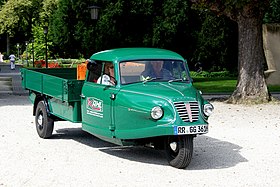| Goliath Goli | |
|---|---|
 Goliath Goli pickup truck | |
| Overview | |
| Manufacturer | Hansa-Lloyd and Goliath-Werke |
| Production | Goliath Company, Bremen, Germany |
| Model years | 1955-1961 |
| Body and chassis | |
| Class | light truck |
| Body style | pickup truck, panel van, freight box |
| Layout | MR layout |
| Powertrain | |
| Engine | two-stroke 465 cc 2l-engine 11 kW (15 hp) at 4000–4500 rpm |
| Transmission | unsynchronized manual 4-speed gear-box |
| Dimensions | |
| Wheelbase | 116–132 in (2,950–3,350 mm) |
| Length | 179–207 in (4,550–5,250 mm) |
| Width | 69–75 in (1,750–1,910 mm) |
| Height | 40,640 mm (1,600 in) |
| Curb weight | 1,609–3,968 lb (730–1,800 kg) or 1,742–3,968 lb (790–1,800 kg) |
| Chronology | |
| Predecessor | Goliath GD750 |
| Successor | none |
The Goliath Goli was a pickup truck or panel van built from 1955 to 1961 by the Goliath division of Borgward in Bremen, Germany. [1] It is the successor of the Goliath GD750 and the last German built three-wheeler truck. Only 9,904 vehicles of this model were produced.
Technology
With its three wheels and a water-cooled two-cylinder two-stroke engine, the Goliath Goli continued a design principle that had long been a thing of the past for other vehicle manufacturers. Decisive for the use of only three wheels was the vehicle's approximately 30% lower production price. The Goliath Goli incorporated a sophisticated design. The engine was mounted behind the front wheel and provided a low centre of gravity, and the 6.40×13 tires ensured an optimum of stability and drive safety for a freight tricycle. Initially, an air-cooled engine rated 12.5 kW was used, but it had thermal problems. From 1957, a different 465 cm³ engine with water-cooling was used. The power of this engine was 11 kW. It was deemed too weak for a 0.75 t freight vehicle. Maximum torque was only 34 N·m at 2500 rpm. At full load, the vehicle had a power-to-weight ratio of 160 kg/kW. To avoid further bad criticism, Goliath offered replacing the air-cooled engine with a passively thermosiphon-cooled one for free. The Goli had a U-profile ladderframe, a control arm with a quarter elliptical spring for its front wheel, a solid rear axle with progressive leaf springs, a worm drive steering system, a hydraulic three wheel braking system, a parking brake for the rear wheels, and an all-steel cab. The 6 volts electric starter did not have a magnetic switch, instead, it was manually connected to the engine using a hand lever. The Goli's top speed was 60 km/h (37 mph). Fuel consumption was 7.5 l/100 km (31 mpg). Climb rate limit at full load was 23, 12, 7, 3% (depending on the gear). The turning radius is 11 m (36 ft).
Variants
The flatbed version was available in a low and a high variant. The lower variant offered a capacity of 6 m³ (211 cft). There was also the full-metal panel van and separated freight box body variant. The vehicles external dimensions of the freight box variant were 2200 × 1460 × 1230 mm (68 × 58 × 9 inch). Depending on body and tires, the payload was 750 to 950 kg (1653 to 2094 lb). [2]
-
Dashboard of the Goli
-
Goli with panel van body
-
Wheel suspension and steering
References
- ^ Kurze, Peter (2005). Liefer- und Lastwagen aus Bremen: Nutzfahrzeuge seit 1945 von Borgward, Hanomag und Mercedes (in German). Verlag Peter Kurze. p. 2040. ISBN 9783927485464.
- ^ (German) Aus dem internationalen Kraftfahrzeugbau – Goliath-Dreirad-Kleinlaster mit Zweitaktmotor., Kraftfahrzeugtechnik, July 1959, p.289
External links
- List of remaining Goliath vehicles Archived 2019-02-25 at the Wayback Machine, retrieved February 2019


